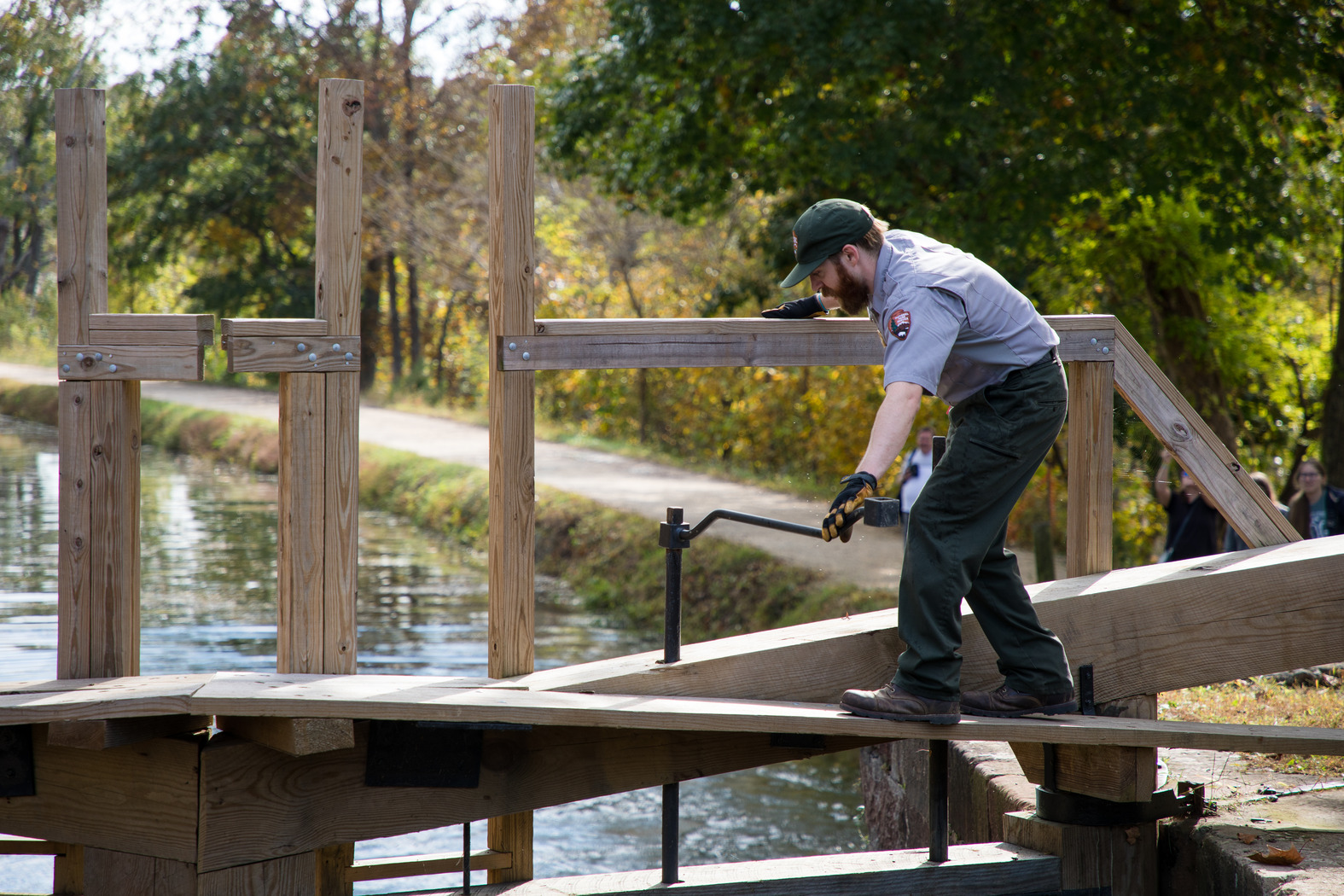 Right Side: Canal Boat Entering a Lock Left Side: Park Ranger Using a Lock Key Introducing, the Lock keeper!There are 74 Lift Locks along the Chesapeake and Ohio Canal. The C&O Canal Company required that each Lift Locks were operated and monitored by hired staff. These hired staff would be given a Lockhouse near the lift lock(s) they were to operate, an acre of land to farm, and a yearly salary. They called these people lock tenders or lockkeepers.  Lockkeeper operating a Lift Lock Lockkeeper operating a Lift LockNPS/ Harpers Ferry Center Duties of a LockkeeperThere were many responsibilities a lock keeper must do besides operating a Lift Lock.
Reputable LockkeepersEven though many of the lock tenders were undisciplined and indifferent to their responsibilities, there were some whose devotion to their duties were recognized and rewarded. Some lockkeepers were promoted to positions as division superintendents in recognition of their responsible contribution to the operation of the canal.During the summer of 1841, then company finances were desperately low, the keepers and other officers either were not paid for months or received their pay in lower amounts, as much as 50%. Even though they were not paid for months, there is no indication that many of the lockkeepers left the line during this period. This wasn’t that only time during the canal’s operation that this occurred.To lock keepers demonstrated their loyalty to the canal company under similar circumstances during the waning years of the independent existence of the waterway.
Family Roles Synder Family Synder FamilyNPS The C&O Canal company preferred to hire men with large families. They deemed that married men would provide a more responsible service along the numerous isolated stretches of the canal than would those were single. Larger families meant more hands to do work, which worked to the advantage of lockkeepers managing more than one lock. Older children could operate the locks, relieving the lockkeeper’s need to hire an assistant. More about Lockkeepers!Performance RecordWhile there were many safeguards taken when choosing lockkeepers, the records show that many lock men were undisciplined and irresponsible. Most lockkeepers were diligent in their work, but many were dismissed for drunkenness, neglect of duty, and absence without notice or without providing a substitute. Lockkeepers were prohibited from selling alcohol to boatmen and workers, but frequent complaints were made about the sale of liquor on the canal.Just after a few years of canal operations, the directors had become alarmed by the numerous reports of negligence and irresponsibility. On March 24, 1832, they ordered the superintendent to interview each lock tender and remind them what their duties are. If the superintendent found any lock keeper ignorant of his duty, in any way negligent, or remiss in performance, he was to report them to President Mercer. In addition, the directors ordered the Superintendents to instruct the lockkeepers to make daily and weekly inspections of the embankments on both sides of the canal within their respective districts. They were to look for evidence of musk rats lodging and leaks in the culverts. If anything was found, they were to promptly stop or make effective measures to prevent their enlargement. The lockkeeper would also now be responsible for any damage and any injuries at their lock and the payment to those costs would come from that lock keeper’s next month’s wages. The public also became troublesome. To avoid the tolls made by the Harpers Ferry Road Company, people would cross the bridge at Lock No. 31. Then use the towpath for the distance between the lock and Harpers Ferry. The Harpers Ferry Road Company complained to the canal board. Anxious to cooperate with the road company as well as protect its works, the lockkeeper was ordered to enforce the company rules and prohibit persons from crossing the bridge unless they were on canal business or were passing to or from Casper Wevers Mill for whose immediate use the bridge had been constructed. Lockkeeper's WagesFrom 1831 to 1853, their annual wages remained unchanged. The pay for skilled factory workers ranged between $200 to $500 annually. The lockkeepers were considered unskilled workers - their pay ranged between $50 to $300 annually. |
Last updated: December 16, 2023

